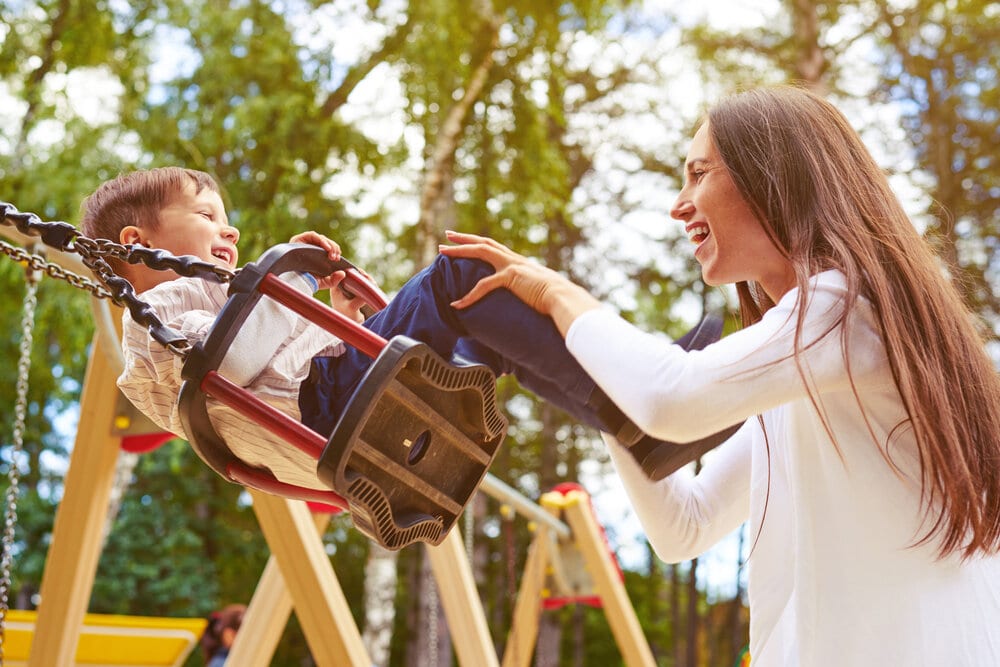Learning a new language can be a lot of fun. In fact, according to many studies, some advantages of getting a new language under your belt include improved brain function and memory, better multi-tasking skills and boosted creativity, just to name a few.
One such foreign language that we’ll be focusing on is Spanish and how we can sprinkle a few phrases throughout the day with our children. Specifically those words and phrases that can be helpful while having fun on the playground.
Introductions
Kids tend to be social creatures and the playground is the perfect place for them to meet new friends, all day long. So it is perfect that they must introduce themselves and introduce you to their new pal. When your child returns from playing with a new friend, you may ask the name of their new pal, and the conversation would flow like this:
¿Cómo se llama? – What is his/her name?
Your child will then respond by saying: Se llama…{insert friend’s name here}
For example: ‘Se llama Alex’ or ‘Se llama Pedro’ which translates to ‘Her name is Alex’ or ‘His name is Pedro.’
Food for thought: ‘Se llama’ is gender-neutral, so regardless of whether your child’s friend is a boy or girl, it remains the same.
Also, it cannot be stressed enough that it would be better not to translate the words as children will naturally decipher the meaning from the context. The more you make this a habit, it just becomes second nature that your child’s vocabulary and yours too, will have that zest of Spanish flair.
Commands
Your child may want to go on the swings but there are a few kids also waiting too. So they start shoving, pushing or being rowdy, which can be very dangerous. So as a parent try saying, “no empujar” which means ‘No pushing’ and to add, you can also say ‘formen una línea’ telling them to form a line instead. Simpler phrases that you could use include: ‘Cuidado’ which means ‘Careful’ and you’ll probably say this one a lot, because though the playground can be the best place on earth for a child, it is also full of trips and breaks just waiting to happen, that, as a parent, one has to be careful.
Food for thought: ‘Cuidado’ which translates to ‘Be Careful!’ has a very unique pronunciation. In Spanish, the ‘d’ intimates the ‘th’ sound, as in the English word ‘those’, and to ensure that you’re tapping into that beautiful accent, try putting your tongue between your teeth or right behind your top teeth, when pronouncing the word.
Additionally, some more general phrases that you may use with your child are listed here:
It would be helpful that when saying these phrases that you do the accompanying action, for example, out-stretching your hand. This is because some children are more inclined to understand the meaning that way and not necessarily hinged on the fact that you’re speaking another language.
-
Give me your hand- Dame la mano
-
Take my hand- Toma la mano
-
Walk, please- Camina, por favor
-
Don’t run- No corras
-
Come here- Ven
-
Don’t touch- No toques
-
Sit down- Siéntate
What’s the most exciting thing about the playground for your child? Some may have a love at first swing experience and nothing gives them more of a thrill. Perhaps it’s the see-saw, sandbox or the monkey bars- the list is endless. However, try teaching your child how to say their favorite outdoor activity in Spanish, and don’t worry, here are a few:
-
swings- los columpios
-
monkey bars- el pasamanos
-
slide- el tobogan
-
see-saw- el sube y baja
Pronunciation
Spanish is a rich and beautiful language and is laced with so many complexities. Here are a few tips on how to improve your pronunciation as both you and your child converse:
-
Spanish vowels are pronounced the same every time. Take some time to learn ah, eh, ee, oh, oo, and you’re golden. Here is a video that may help and have you speaking like a natural.
-
It’s important to note the length of the vowel sound. Spanish vowels are pronounced shorter, more abruptly. In English, we tend to let vowels drag on. For example, many English speakers pronounce hola, which has two short and sweet vowels, as ooouulaaah. They let the o and a drag on for far too long. Instead, try giving each vowel in hola a half-second of sound. Short and sweet.
-
When the Spanish letter g precedes u, a or a consonant, it’s a bit like the hard English “g” found in “grape” or “gorilla.” The only difference from this English letter “g” sound is, as with any Spanish consonants, the Spanish g is pronounced a bit softer.
-
The letter j has a breathy “h” sound, like the “h” in “house.” You may already know this thanks to Spanish loan words in English—for example, jalapeño is pronounced as ha-la-payn-yoh or empujar= em-poo-har.
Speaking Spanish can be an amazing experience and though it can be a bit of a challenge, especially if you’re not a native speaking- there is no reason to be daunted. Also, Spanish can really add that flair to both you and your kids’ vocabulary, especially on the playground. Keep engaging in conversations every week and let them tell you about what they like or who they met at the park- you won’t regret it.
Check out a class for just $12 – $17 bucks! Our methods are tried and proven so you can be confident in your child learning effectively learning Spanish. If you have any questions, please don’t hesitate to contact us. We’ll be more than happy to help!


